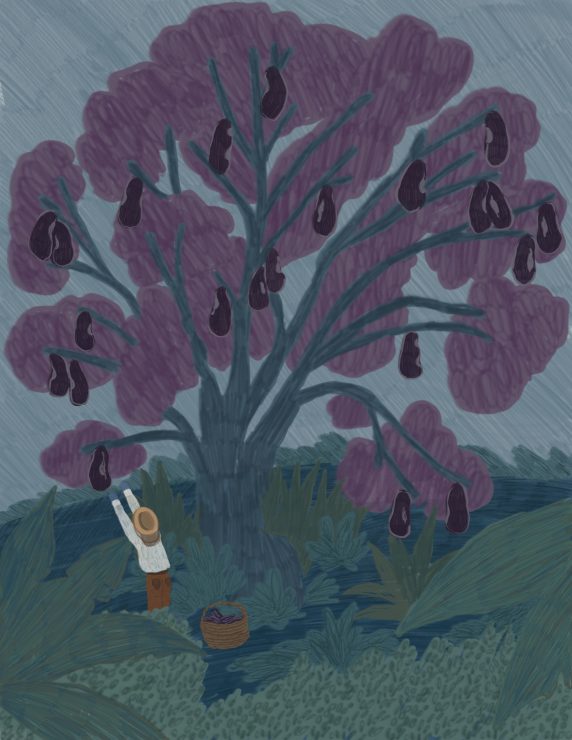Student projects work to decrease the environmental impact of cacao farms and support those who run them

Illustration by Chloe Latour.
Chocolate is one of the world’s most beloved commodities, but there’s a dark story behind the source of this sweet treat.
In its rawest form, chocolate begins as bean pods grown on cacao trees, found close to the equator. Strict growing conditions and limited yield per tree means farmers struggle to keep up with global chocolate demands.
Cacao farms can be major climate change contributors. According to chocolate company To’ak, in the worst cases they operate by replacing the diversity of tropical rainforests with a single species of cacao tree. Additionally, farmers work in less than ideal conditions and are often not compensated well for their labour.
“I don’t think the world is going to stop eating chocolate tomorrow,” says Michaela Meil, a member of the UVic’s Environmental Governance Group who is researching how corporations import cacao into Canada. Many students, like Meil, are taking their love of chocolate to the next level by looking for solutions to help the environment and the lives of cacao farmers. One such solution is encouraging farms to get Fairtrade certification.
Fairtrade is a certification that appears as a blue and green symbol on products, something 57 per cent of Canadians recognize according to Fairtrade Canada. It signals to the buyer that the farmers behind that product were equitably paid and treated.
“What’s good about Fairtrade is that you do have to meet [certain] social and environmental standards,” says Meil. According to Fairtrade International, such standards include minimal use of agrochemicals and pesticides on farms, prohibiting child labour, and encouraging farmers to invest money into their businesses and communities. “We’re ensuring to the consumer that they’re buying chocolate from a farm that’s more ethically sourced than what you get from somewhere else.”
The ‘somewhere else’ Meil discusses refers to corporations such as Lindt or Hershey, which Meil says aren’t ethically sourced because it’s difficult to track the origins of their products, making it harder to fairly pay farmers.
Meil describes this issue using an image of an hourglass. On one end are the many farmers who contribute to the global chocolate industry, and on the other are customers. The middle represents the very few traders who control where the money goes in the supply chain, ultimately leading to unfair pay for the farmers.
The problem is that farmers don’t have an incentive to go Fairtrade. For many farmers, the process is expensive and time-consuming. It’s easier to commit to their immediate plans of making money to support their families. How, then, can we provide security for farmers so that they can afford to go Fairtrade?
Thankfully, Meil isn’t the only UVic student working on this issue. Third-year undergraduate geography major and chocolate sommelier Madison Ashton is working on a research project called “Beyond Cacao” that aims to increase farmer’s income security and diversity through selling non-cacao products such as nuts, spices, and fruits. She wants to know if chocolate makers in direct trade relationships with cacao farmers are more willing to buy their non-cacao products to use in chocolate products.
Ashton says her research project was inspired by Taylor Kennedy of Sirene, a Victoria-based chocolate maker, who visited the farm where his cacao is grown. When Kennedy saw that the farmers also grew cardamom, he started buying and using it in his products.
Ashton also works at The Chocolate Project, a bean-to-bar retailer in Downtown Victoria. The retailer sells bars from local businesses like Sirene and runs classes to educate the public.
“There are a lot of barriers to supporting the cacao farmers,” says Ashton. “We really want to show people in Victoria just how many issues there are with commercial chocolate.”
Other students have been involved with this issue on site. For her UVic Honours research, Sarah Rebitt took her research closer to cacao’s origin. She visited Belize for two weeks to learn how soil quality relates to the yield of cacao. She worked alongside the Belize Foundation for Research and Environmental Education and local Belizean farmers with the goal of producing more of an unconventional strain of cacao called Criollo cacao.
“Criollo specifically likes shade … It grows better in an agroforestry environment where there’s big rainforest trees surrounding the cacao,” says Rebitt. Unlike typical full sun monoculture cacao farms, agroforestry systems welcome the inclusion trees instead of cutting them down.
Growing more of these diverse agroforestry systems could be a great way to reduce the deforestation that can come with cacao farming.
“One of the reasons I was conducting this research was to promote cacao in Belize,” she says. “They want to find this ideal system where this Criollo cacao grows and share that with other farmers in Belize to encourage people to grow this cacao.”
So what can the public do? In all, Meil suggests “using your dollar if you can” on Fairtrade or bean-to-bar chocolate. What’s more, educating ourselves and using our voices to spread awareness about the origins of chocolate and associated problems is an equally powerful tool.
“There is a better way we can support cacao farmers,” says Ashton. “And while we’re doing that … [we can] get some much better chocolate out of it, too.”








